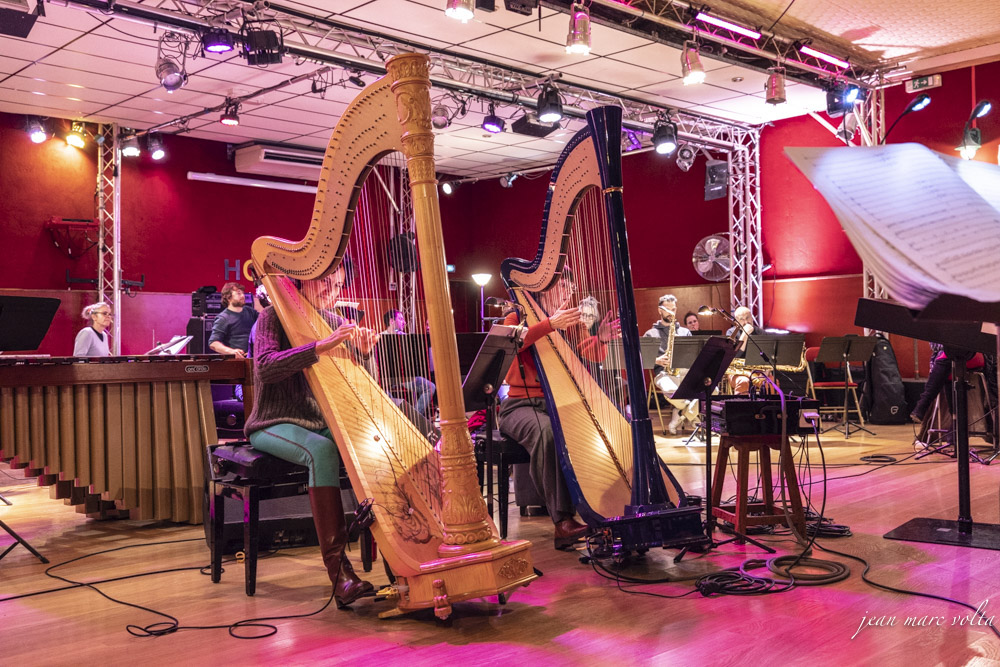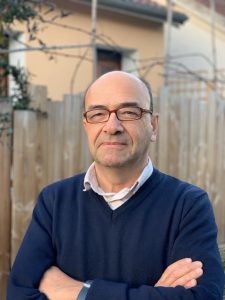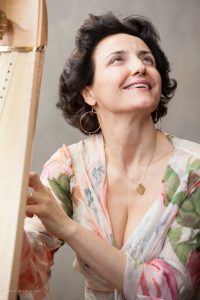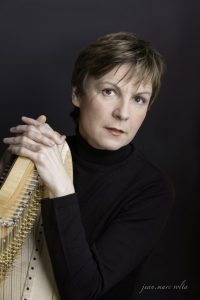Camac Blog
“En blanc and blue”: Concerto for amplified concert harp, electric blue harp and jazz orchestra
Latest
February 7, 2022
Radio France’s 32nd new music festival Présences 2022 has programmed an exciting new harp concerto. Christophe de Coudenhove’s “En blanc and blue” will be premiered by Isabelle Moretti (concert harp), Ghislaine Petit-Volta (blue harp) and the Orchestre National de Jazz under the direction of Frédéric Maurin.
It’s not the first time Christophe de Coudenhove has composed for the harp. Professor of composition and music technology at the Bourg-La-Reine Conservatoire, he has been closely associated with that conservatoire’s “Odyssée de la harpe” festival. This is an annual event created in 2006 by Ghislaine Petit-Volta, and which has been expanding the repertoire of the electric blue harp ever since. For the festival, de Coudenhove created “Harpes de toutes couleurs” (2008) for electric harp, 4 acoustic pedal harps, 1 lever harp, sound processing and video, plus a first version of “En blanc and blue”. There is also his “Bleu” (1998) for flute, blue harp, percussion and sound processing, commissioned by Martine Flaissier’s Trio Controverse.
When “En blanc and blue” was commissioned, de Coudenhove had no background in jazz. He listened to it intensely in preparation. “With hindsight,” he says, “I had been influenced by jazz before, and it does come out in my earlier writing. I’d particularly mention Oscar Peterson’s album “Tracks”, Gil Evans, a melody by Joe Zawinul, the album “Bitches Brew”, and two concerts by Miles Davis – one at the Isle of Wight Festival in 1970, the other in Tokyo in 1985.
In any case, before “En blanc and blue” I was listening to a lot of jazz and making wonderful discoveries. But what was I going to do with it all? I had to process and appropriate it, to find the musical language I wanted.
One day, at the keyboard, I happened upon a chord made of two superimposed fourths, placed on a semitone: E/F/Bb/Eb. Suddenly, I felt that this chord contained what I was looking for: jazz colours (the fourths), and the harmonic tension of the musical language I know (the semitone E-F, and the 7th from E-Eb). This captured my imagination. As a result, I constructed twelve chords on a descending chromatic bass, a melodic theme around an ascending chromatic structure, developed these elements, and added other jazz ideas such inside/outside and walking bass. I had my material!”
As such, “En blanc and blue” is an adventure in form. De Coudenhove continues: “The adventure begins with harmonic material. It undergoes all sorts of transformations, generating different forms with different characters over time. For example, the second movement is a slow ballad, the third movement is full of rhythmic interplay, and the first movement is a crazy race! Moreover, the classical scoring for the harps, with their virtuoso arpeggios, brings a mysterious new flavour to the jazz ensemble. It is tinged with sweetness and lyricism, and also mobility and humour!”
It is also a joyful adventure for the soloists. Clearly, Isabelle Moretti and Ghislaine Petit-Volta are classical harpists. Their concerto parts do not uproot them from their tradition; instead, they form a counterpoint to the jazz orchestra. Two worlds meet in multiple dialogues: between the orchestra and the soloists, and between the two soloists themselves.
“While composing, I wanted to please everyone”, explains Christophe de Coudenhove. “The soloists of course, and the National Jazz Orchestra, who are all soloists when they are improvising. I also had to be true to myself, and there is no question of my pretending to be a jazz composer. So I created several moments in the concerto where the instrumentalists take to the floor as soloists. These are in the spirit of classical solos, but there are also two moments of improvisation on chord grids, thus completely in the jazz tradition. There, as a composer I hand over all the control completely to this prestigious jazz ensemble.”
If it is possible to summarise the experience, one could say it is one of intense listening. Describing the rehearsals with the jazz orchestra (which were allocated a more generous amount of time than is usual for a classical concerto, incidentally), the soloists agree they are “somehow richer in terms of listening” (Ghislaine Petit-Volta). Isabelle Moretti concurs: “The jazz orchestra principally connects by listening to each other. The jazz musicians are very serious about their work, but do not let that restrict their joy in playing. It is very pleasant to work in such a light-hearted, uncomplicated atmosphere, which is not often the case in classical music!”
“We are happy and very joyful during rehearsals,” adds Ghislaine. “The fact that everything is not written down gives more freedom and less anxiety. Jazz musicians aren’t interested in mistakes, they are above all that. Also, the fact that jazz is taught in music colleges means they read music, which was not always the case in the past. This makes truly multidisciplinary writing like Christophe’s possible. For example, he can notate rapid meter changes from 5/8 to 7/8, and other things that aren’t really in the jazz tradition.”
There is also the question of the harp writing. The concert harp is simply amplified; the blue harp is treated with effects. These were all pre-programmed by Christophe de Coudenhove. “The blue harp and its “traditional” effects processor (the Digitec TSR-12) allowed me to integrate the sound of the harp into the rich sonic environment of the 16-instrument jazz band. I have approached the sound processing in two ways. Firstly, I’ve deployed a familiar bank of reverb, delay, chorus, flanging, etc. Secondly and particularly in the first movement, I’ve invented original sounds and built the form and the orchestration around them. For example, I created a continuous glissando over about a minor third that is triggered by plucking a string; a deep gong/gamelan-like sound that transforms the harp into a percussion instrument; and another trigger of a strange, tremulous chord.”
Even the title of the concerto combines multiple associations. “En blanc and blue” means that the concerto uses two types of harps, one acoustic (the “blanc”, or white) and the other electric (the blue). It also alludes to blues as in jazz… and to the title of Debussy’s “En blanc et noir”. “Blue” is not a typo in the French title! “I prefer the title in two languages,” explains de Coudenhove. “It evokes more associations.”
If you are in Paris on February 11 at 10:30 pm, come and experience the concerto for yourselves at the Maison de la Radio et de la Musique, Studio 104. Can’t be there? Tune in to France Musique at the same time for the live broadcast.




